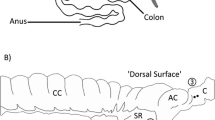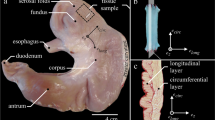Abstract
Purpose
We examined the electrical and mechanical characteristics of the smooth muscles in the human colon at the muscle cell, the muscle strip, and at the whole tissue levels
Methods
Conventional microelectrode recordings and tension recordings were performed.
Results
There was no difference in resting membrane potential, frequency, and amplitude of slow waves between the right and left colon; but there were significant differences in frequency and amplitude of the slow waves between inner circular muscle (CM) and longitudinal muscle (LM), and between inner CM and outer CM, but not between outer CM and LM. On tension recording of CM and LM strip and colonic segment, amplitude, frequency, and area under the curve showed no difference between the right and left colon. In whole colonic segment, high amplitude dominant waves (DW) were found both in CM and LM. Low amplitude non-DWs were detected only in CM, more commonly in right colon and propagated aborally. DWs in the CM were associated with DWs in the LM. In the CM of the left colon, all DWs in the CM propagetd aborally ending-up with DW in the LM layer. However, in the right colon, mixed pattern of propagation was detected in adjacent recording sites in 60% of tissues examined.
Conclusion
Electrophysiologic and mechanical characteristics were similar between the right and left human colon. However, the retrograde propagation of both DWs and non-DWs in the CM was more frequent in the right colon, accounting for mixing function in this region of the human colon.





Similar content being viewed by others
Abbreviations
- CM:
-
circular smooth muscle
- LM:
-
longitudinal smooth muscle
- DW:
-
Dominant wave
- AUC:
-
area under the curve
References
Sanders KM (1996) A case for interstitial cells of Cajal as pacemakers and mediators of neurotransmission in the gastrointestinal tract. Gastroenterology 111(2):492–515
Suzuki H (2000) Cellular mechanisms of myogenic activity in gastric smooth muscle. Jpn J Physiol 50(3):289–301
Farrugia G, Holm AN, Rich A, Sarr MG, Szurszewski JH, Rae JL (1999) A mechanosensitive calcium channel in human intestinal smooth muscle cells. Gastroenterology 117(4):900–905
Hara Y, Kubota M, Szurszewski JH (1986) Electrophysiology of smooth muscle of the small intestine of some mammals. J Physiol 372:501–520
Sanders KM, Koh SD, Ward SM (2006) Interstitial cells of cajal as pacemakers in the gastrointestinal tract. Annu Rev Physiol 68:307–343
Smith TK, Reed JB, Sanders KM (1987) Interaction of two electrical pacemakers in muscularis of canine proximal colon. Am J Physiol 252(3 Pt 1):C290–299
Lee HT, Hennig GW, Park KJ (2009) Heterogeneities in ICC Ca2+ activity within canine large intestine. Gastroenterology 136(7):2226–2236
Huizinga JD, Waterfall WE (1988) Electrical correlate of circumferential contractions in human colonic circular muscle. Gut 29(1):10–16
Huizinga JD, Stern HS, Chow E, Diamant NE, El-Sharkawy TY (1985) Electrophysiologic control of motility in the human colon. Gastroenterology 88(2):500–511
Rae MG, Fleming N, McGregor DB, Sanders KM, Keef KD (1998) Control of motility patterns in the human colonic circular muscle layer by pacemaker activity. J Physiol 510(Pt 1):309–320
Nakanishi S, Kakita S, Takahashi I (1992) Wortmannin, a microbial product inhibitor of myosin light chain kinase. J Biol Chem 267(4):2157–2163
Huizinga JD, Diamant NE, El-Sharkawy TY (1983) Electrical basis of contractions in the muscle layers of the pig colon. Am J Physiol 245(4):G482–491
Sanders KM, Stevens R, Burke E, Ward SW (1990) Slow waves actively propagate at submucosal surface of circular layer in canine colon. Am J Physiol 259(2 Pt 1):G258–263
Du CA, Conklin JL (1989) Conklin, origin of slow waves in the isolated proximal colon of the cat. J Auton Nerv Syst 28(2):167–177
Liu LW, Farraway L, Berezin I, Huizinga JD (1998) Interstitial cells of Cajal: mediators of communication between circular and longitudinal muscle layers of canine colon. Cell Tissue Res 294(1):69–79
Xue W, Minocha HC (1993) Minocha, Identification of the cell surface receptor for bovine viral diarrhoea virus by using anti-idiotypic antibodies. J Gen Virol 74(Pt 1):73–79
Komuro T (1999) Comparative morphology of interstitial cells of Cajal: ultrastructural characterization. Microsc Res Tech 47(4):267–285
Smith TK, Reed JB, Sanders KM (1989) Electrical pacemakers of canine proximal colon are functionally innervated by inhibitory motor neurons. Am J Physiol 256(3 Pt 1):C466–477
Smith TK, Reed JB, Sanders KM (1988) Effects of membrane potential on electrical slow waves of canine proximal colon. Am J Physiol 255(6 Pt 1):C828–C834
Smith TK, Reed JB, Sanders KM (1987) Origin and propagation of electrical slow waves in circular muscle of canine proximal colon. Am J Physiol 252(2 Pt 1):C215–C224
Fida R, Lyster DJ, Bywater RA, Taylor GS (1997) Colonic migrating motor complexes (CMMCs) in the isolated mouse colon. Neurogastroenterol Motil 9(2):99–107
Kirk D (1981) An electrophysiological study of the smooth muscle of the human colon. Ann R Coll Surg Engl 63(6):393–398
Riezzo G, Maselli MA, Pezzolla F, Thouvenot J, Giorgio I (1992) In vitro electro-mechanical activity of the human colon. Simultaneous recording of the electrical patterns of the two muscle layers. Arch Int Physiol Biochim Biophys 100(1):93–100
Acknowledgments
This study was supported by the grant from the Clinical Research Institute, Seoul National University Hospital (Grant No:0620081849)
Author information
Authors and Affiliations
Corresponding author
Additional information
Podium presentation at the biennial congress of the International Society of University Colon & Rectal Surgeons, San Diego, CA, USA, September 13-17, 2008
Rights and permissions
About this article
Cite this article
Choe, E.K., Moon, J.S., Moon, S.B. et al. Electromechanical characteristics of the human colon in vitro: is there any difference between the right and left colon?. Int J Colorectal Dis 25, 1117–1126 (2010). https://doi.org/10.1007/s00384-010-0966-x
Accepted:
Published:
Issue Date:
DOI: https://doi.org/10.1007/s00384-010-0966-x




